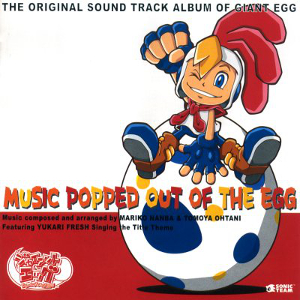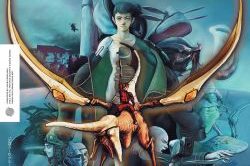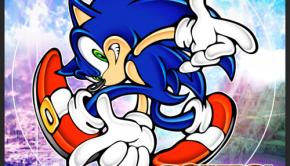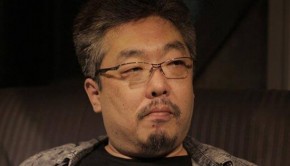Billy Hatcher and the Giant Egg Soundtrack
 |
Album Title: Billy Hatcher and the Giant Egg Soundtrack (The Original Soundtrack Album of Giant Egg -Music Popped Out Of The Egg-) |
| Record Label: Wavemaster |
|
| Catalog No.: WWCE-31005 |
|
| Release Date: November 6, 2003 |
|
| Purchase: Buy at CDJapan |
Overview
Dr. Suessian is the word that comes to mind from the Billy Hatcher and the Giant Egg Soundtrack. It is a fine, whimsical collection of nostalgically-childish sounds and compositions courtesy of Sonic series composers Mariko Nanba and Tomoya Ohtani. Never before has a video game soundtrack ever been so unabashedly flute-heavy. Billy Hatcher commands the use of the flute, turning a single instrument into somewhat of a motif. Middle-Eastern, Carribean, and even prehistoric-sounding funk aren’t safe from the recurring instrument! The soundtrack never loses it’s gusto; rarely will you find a desert song as fast and fun as Billy Hatcher‘s. This is not a focused collection of music, it jumps between it’s multiple genres like an impatient child running through a toy store. Yet, that is the fun of the Billy Hatcher and the Giant Egg Soundtrack in a nutshell. It makes the listener feel just as immature as the music is.
Body
“G.I.A.N.T.E.G.G. ~Opening Theme~” throws you right into it’s madness. Children start by spelling out the titular GIANTEGG, then cut off by a rooster call. Brass trumpets blare as the childish voices hum the game’s immediately catchy recurring riff. “G.I.A.N.T.E.G.G. ~Opening Theme~” does a spectacular job of not just throwing the players into the world of the game, but also the world of the soundtrack. As said before, this is not a focused soundtrack. Neither is this song. It jumps between a fast pace, slow pace, nonsense singing, letter spelling, and rarely sticks with anything for too long. It perfectly sets the tone of Billy Hatcher by giving the listener a chance to get into the right mindset.
Two songs from the game’s first forest world, “Tumbling Xylophone” and “Take Upper Fruit”, compliment the game’s opening track. A similar use of brassy trumpets punctuates “Tumbling Xylophone” while the breezy instrument from the track’s title keeps a wistful, lackadaisy pace. Billy Hatcher‘s signature flute is on full display here and provides the main melody of the song.”Take Upper Fruit”, however, uses a the same melody and dials it up to 11. The drums are more akin to a Sonic the Hedgehog game, hard hitting and appropriately fast. All together, these three tracks are the most representative of the soundtrack as a whole. They’re the most whimsical of the bunch; there isn’t so much theming here as there is putting you into the universe of the game.
I’m going to go off the record here and be a little blunt; “Let’s Go Easy” is my favourite song in the entire game. If I could make a list of the Top 20 Songs in Video Game History, this would be an easy choice for a contender. Of course, that’s just my opinion. The second track from the game’s pirate-themed world, it uses a continuous infectious groove that never lets up in the entire song. Compared to anything on the soundtrack, this is Billy Hatcher at it’s most focused. The trumpets are less brassy, they compliment the beat rather than punctuate it. A recurring use of a piano and bongo drums gives “Let’s Go Easy” a unique vibe. It’s never quite a Beach-Theme; Tomoya Ohtani used a much more tropical sounding track selection in the “Tropical Coast” levels from Sonic Lost World. It’s a unique choice from a composition standpoint to use the world’s associating instruments to compliment rather than dominate. Again, off the record, this is Billy Hatcher at it’s finest.
Tracks like “Rumbling Blues”, “Pop a Parade”, and “Sandstorm Sitar” show Billy Hatcher at it’s least stylized. “Rumbling Blues” sounds like a lava theme, using a tribal-sounding drum beat and a bass-guitar to give it an ominous feel. As if the stalactites around Billy are ready to crumble and put his journey to an end. “Pop a Parade” has distorted instruments and a carnival-like atmosphere. It is as if you were on a ferris wheel overlooking a bustling theme park (Or Roller Coaster Tycoon, at least). “Sandstorm Sitar” uses the titular instrument to give the impression of a sandy, dune filled area. Yet, there’s plenty of originality at play here.
The better word for how Billy Hatcher uses these familiar music elements is “appropriation”. Sure, it sounds like a lava level, but the inclusion of playful, bouncing synths swings “Rumbling Blues” right back into childish territory. “Pop a Parade” sounds like a carnival, but the instrument choices are all Billy Hatcher and it sticks to the distinct sound of the album. Even “Sandstorm Sitar”, something I include under a label of video game “Desert Themes”, manages to avert the tropes that pledge it’s brethren before it. Rather than keeping it slow and using its sitar to simply just sound like “desert music”, it ups the tempo and keeps the entire song upbeat. The main melody is not the sitar; it’s the flute motif. Choices like these show how a game soundtrack can appropriate the classic tropes of the level-types they are for. It can warp them into their own distinct style. Even though “Sandstorm Sitar” sounds like a “desert theme”, it’s Billy Hatcher‘s Desert Theme.
So, where does the Billy Hatcher Soundtrack falter? The OST has three settings: unfocused madness, (rarely) focused madness, and out-of-place melancholy. When it comes to the game’s plot, Billy Hatcher doesn’t provide anything new. Kids get magical rooster suits and take on a bunch of baddies called Crows. It’s baffling to me why the composers have chosen to give the final boss such a slow and out-of-place track. “Bossy Crow” is the final battle theme of the game, used when you face it off with the Dark Raven. Apocalyptic-Jazz is the closest genre I can find for this track. The drums give off the illusion of a faster song, but the swelling violins, dissonant trumpets and brass, and surreal composition combine together to make something that just doesn’t work. If it sounds like I’m being a little too hard on this song: consider this.
“Bang! Bang! Bang! Big Hornes Explosion” is the game’s other boss theme, and it is an over-the-top big-band number. Every time the trumpets blare along with the other instruments, it sounds like a genuine explosion. You can almost hear our triumphant hero Billy hitting the crows with his eggs, or unleashing a creature to aid in the battle (this is an awesomely weird game). It’s really hard to appreciate “Bossy Crow” when a song with a blatantly more interesting composition is used for the other boss fights. What works in the context of the game doesn’t always work when you aren’t listening to it in context. Even so, “Bossy Crow” is easily the games biggest misstep. Ironic, that the lack of focus that I so heavily laud brings the soundtrack it’s biggest dud.
Summary
The Billy Hatcher and the Giant Egg Soundtrack is a one-of-a-kind. It’s immensely refreshing to hear a soundtrack so passionate about the way it sounds and how confident it is in it’s individuality. Despite the occasional questionable choice, this soundtrack was made for Billy Hatcher and Billy Hatcher alone. Even if you’ve never played the game, it stands out beautifully as a mish-mash of musical styles. It isn’t the longest soundtrack; 29 songs with a few of them being bonus tracks that don’t factor much into the actual game. Still, this makes listening to every song a breezy experience and is easily worth investing an hour into.
Do you agree with the review and score? Let us know in the comments below!
4
Posted on September 5, 2015 by Chris Hayman. Last modified on September 5, 2015.














